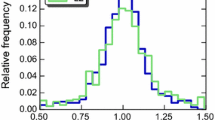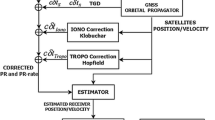Abstract
Precise science orbits for the first 4 years of the Swarm mission have been generated from onboard GPS measurements in a systematic reprocessing using refined models and processing techniques. Key enhancements relate to the introduction of macro-models for a more elaborate non-gravitational force modeling (solar radiation pressure, atmospheric drag and lift, earth albedo), as well as carrier phase ambiguity fixing. Validation using satellite laser ranging demonstrates a 30% improvement in the precision of the reduced dynamic orbits with resulting errors at the 0.5–1 cm level (1D RMS). A notable performance improvement is likewise achieved for the kinematic orbits, which benefit most from the ambiguity fixing and show a 50% error reduction in terms of SLR residuals while differences with respect to reduced dynamic ephemerides amount to only 1.7 cm (median of daily 3D RMS). Compared to the past kinematic science orbits based on float-ambiguity estimates, the new kinematic position solutions exhibit a factor of reduction of two to three in Allan deviation at time scales of 1000s and higher, and promise an improved recovery of low-degree and -order gravity field coefficients in Swarm gravity field analyses.







Similar content being viewed by others
References
Allan DW (1987) Time and frequency (time-domain) characterization, estimation, and prediction of precision clocks and oscillators. IEEE Trans Ultrason Ferroelectr Freq Control 34(6):647–654
Arnold D, Montenbruck O, Hackel S, Sosnica K (2018) Satellite laser ranging to low Earth orbiters: orbit and network validation. J Geodesy. https://doi.org/10.1007/s00190-017-1090-2
Bock H, Dach R, Jäggi A, Beutler G (2009) High-rate GPS clock corrections from CODE: support of 1 Hz applications. J Geodesy 83(11):1083–1094. https://doi.org/10.1007/s00190-009-0326-1
Cerri L, Berthias J, Bertiger W, Haines B, Lemoine F, Mercier F, Ries J, Willis P, Zelensky N, Ziebart M (2010) Precision orbit determination standards for the Jason series of altimeter missions. Mar Geodesy 33(S1):379–418. https://doi.org/10.1080/01490419.2010.488966
da Encarnação JT, Arnold D, Bezděk A, Dahle C, Doornbos E, IJssel J, Jäggi A, Mayer‑Gürr T, Sebera J, Visser P, Zehentner N (2016) Gravity field models derived from Swarm GPS data. Earth Planets Space 68(1):127. https://doi.org/10.1186/s40623-016-0499-9
Dach R, Schaer S, Arnold D, Prange L, Sidorov D, Susnik A, Villiger A, Jaeggi A (2017). CODE final product series for the IGS. Astronomical Institute, University of Bern, Bern. http://www.aiub.unibe.ch/download/CODE. https://doi.org/10.7892/boris.75876.2
Dahle C, Arnold D, Jäggi A (2017) Impact of tracking loop settings of the Swarm GPS receiver on gravity field recovery. Adv Space Res 59(12):2843–2854. https://doi.org/10.1016/j.asr.2017.03.003
Doornbos E (2012) Thermospheric density and wind determination from satellite dynamics. Springer, Heidelberg
Friis-Christensen E, Lühr H, Knudsen D, Haagmans R (2008) Swarm—an Earth observation mission investigating geospace. Adv Space Res 41(1):210–216. https://doi.org/10.1016/j.asr.2006.10.008
Hackel S, Montenbruck O, Steigenberger P, Balss U, Gisinger C, Eineder M (2017) Model improvements and validation of TerraSAR-X precise orbit determination. J Geodesy 91(5):547–562
Jäggi A, Beutler G, Prange L, Dach R, Mervart L (2009a) Assessment of GPS-only observables for gravity field recovery from GRACE. In: Sideris MG (eds) Observing our changing Earth. Springer, Berlin, pp 113–123
Jäggi A, Dach R, Montenbruck O, Hugentobler U, Bock H, Beutler G (2009b) Phase center modeling for LEO GPS receiver antennas and its impact on precise orbit determination. J Geodesy 83(12):1145–1162. https://doi.org/10.1007/s00190-009-0333-2
Jäggi A, Dahle C, Arnold D, Bock H, Meyer U, Beutler G, van den IJssel J (2016) Swarm kinematic orbits and gravity fields from 18 months of GPS data. Adv Space Res 57(1):218–233
Johnston G, Riddell A, Hausler G (2017) The international GNSS service. In: Teunissen P, Montenbruck O (eds) Springer handbook of global navigation satellite systems. Springer, Berlin, pp 967–982
Knocke PC, Ries JC, Tapley BD (1988) Earth radiation pressure effects on satellites. In: AIAA/AAS astrodynamics conference, pp 577–587
Laurichesse D, Mercier F, Berthias JP, Broca P, Cerri L (2009) Integer ambiguity resolution on undifferenced GPS phase measurements and its application to PPP and satellite precise orbit determination. Navigation 56(2):135–149. https://doi.org/10.1002/j.2161-4296.2009.tb01750.x
Leick A, Rapoport L, Tatarnikov D (2015). GPS satellite surveying. Wiley, Hoboken
Loyer S, Perosanz F, Mercier F, Capdeville H, Marty JC (2012) Zero-difference GPS ambiguity resolution at CNES-CLS IGS analysis center. J Geodesy 86(11):991. https://doi.org/10.1007/s00190-012-0559-2
Montenbruck O (2003) Kinematic GPS positioning of LEO satellites using ionosphere-free single frequency measurements. Aerosp Sci Technol 7(5):396–405. https://doi.org/10.1016/S1270-9638(03)00034-8
Montenbruck O, Hackel S, Jäggi A (2017) Precise orbit determination of the Sentinel-3A altimetry satellite using ambiguity-fixed GPS carrier phase observations. J Geodesy. https://doi.org/10.1007/s00190-017-1090-2
Olsen N, Finlay CC, Kotsiaros S, Tøffner-Clausen L (2016) A model of Earth’s magnetic field derived from 2 years of Swarm satellite constellation data. Earth Planets Space 68(1):124. https://doi.org/10.1186/s40623-016-0488-z
Pearlman MR, Degnan JJ, Bosworth JM (2002) The international laser ranging service. Adv Space Res 30(2):135–143. https://doi.org/10.1016/S0273-1177(02)00277-6
Peter H, Jäggi A, Fernández J, Escobar D, Ayuga F, Arnold D, Wermuth M, Hackel S, Otten M, Simons W, Visser P, Hugentobler U, Féménias P (2017) Sentinel-1A—first precise orbit determination results. Adv Space Res 60(5):879–892. https://doi.org/10.1016/j.asr.2017.05.034
Picone JM, Hedin AE, Drob DP, Aikin AC (2002) NRLMSISE-00 empirical model of the atmosphere: statistical comparisons and scientific issues. J Geophys Res. https://doi.org/10.1029/2002JA009430
Riley WR (2008) Handbook of frequency stability analysis, NIST Special Publication 1065. National Institute of Standards and Technology, Boulder,
Sieg D, Diekmann F (2016) Options for the further orbit evolution of the Swarm mission. In: Proceedings of living planet symposium, SP-740, p 278
Siemes C, da Encarnação JDT, Doornbos E, van den IJssel J, Kraus J, Pereštý R, Grunwaldt L, Apelbaum G, Flury J, Olsen PEH (2016) Swarm accelerometer data processing from raw accelerations to thermospheric neutral densities. Earth Planets Space 68(1):92. https://doi.org/10.1186/s40623-016-0474-5
Tapley B, Schutz B, Born GH (2004) Statistical orbit determination. Academic Press, London
van den IJssel J, Encarnação J, Doornbos E, Visser P (2015) Precise science orbits for the Swarm satellite constellation. Adv Space Res 56(6):1042–1055
van den IJssel J, Forte B, Montenbruck O (2016) Impact of Swarm GPS receiver updates on POD performance. Earth Planets Space 68(1):85
Wermuth M, Montenbruck O, van Helleputte T (2010) GPS high precision orbit determination software tools (GHOST). In: 4th International conference on astrodynamics tools and techniques, 3–6 May 2010, Madrid
Wettergren J, Bonnedal M, Ingvarson P, Wästberg B (2009) Antenna for precise orbit determination. Acta Astronaut 65(11–12):1765–1771
Zangerl F, Griesauer F, Sust M, Montenbruck O, Buchert B, Garcia A (2014) SWARM GPS precise orbit determination receiver initial in-orbit performance evaluation. In: Proceedings of ION GNSS + 2014, pp 1459–1468
Author information
Authors and Affiliations
Corresponding author
Rights and permissions
About this article
Cite this article
Montenbruck, O., Hackel, S., van den Ijssel, J. et al. Reduced dynamic and kinematic precise orbit determination for the Swarm mission from 4 years of GPS tracking. GPS Solut 22, 79 (2018). https://doi.org/10.1007/s10291-018-0746-6
Received:
Accepted:
Published:
DOI: https://doi.org/10.1007/s10291-018-0746-6




